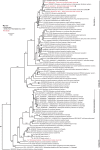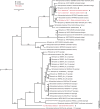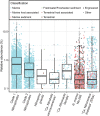Cultivation and genomic characterization of novel and ubiquitous marine nitrite-oxidizing bacteria from the Nitrospirales
- PMID: 37749300
- PMCID: PMC10579370
- DOI: 10.1038/s41396-023-01518-6
Cultivation and genomic characterization of novel and ubiquitous marine nitrite-oxidizing bacteria from the Nitrospirales
Abstract
Nitrospirales, including the genus Nitrospira, are environmentally widespread chemolithoautotrophic nitrite-oxidizing bacteria. These mostly uncultured microorganisms gain energy through nitrite oxidation, fix CO2, and thus play vital roles in nitrogen and carbon cycling. Over the last decade, our understanding of their physiology has advanced through several new discoveries, such as alternative energy metabolisms and complete ammonia oxidizers (comammox Nitrospira). These findings mainly resulted from studies of terrestrial species, whereas less attention has been given to marine Nitrospirales. In this study, we cultured three new marine Nitrospirales enrichments and one isolate. Three of these four NOB represent new Nitrospira species while the fourth represents a novel genus. This fourth organism, tentatively named "Ca. Nitronereus thalassa", represents the first cultured member of a Nitrospirales lineage that encompasses both free-living and sponge-associated nitrite oxidizers, is highly abundant in the environment, and shows distinct habitat distribution patterns compared to the marine Nitrospira species. Partially explaining this, "Ca. Nitronereus thalassa" harbors a unique combination of genes involved in carbon fixation and respiration, suggesting differential adaptations to fluctuating oxygen concentrations. Furthermore, "Ca. Nitronereus thalassa" appears to have a more narrow substrate range compared to many other marine nitrite oxidizers, as it lacks the genomic potential to utilize formate, cyanate, and urea. Lastly, we show that the presumed marine Nitrospirales lineages are not restricted to oceanic and saline environments, as previously assumed.
© 2023. The Author(s).
Conflict of interest statement
The authors declare no competing interests.
Figures





References
-
- Ward BB. Nitrification in marine systems. In: Capone DG, Bronk DA, Mulholland MR, Carpenter EJ, editors. Nitrogen in the marine environment. Burlington: Academic Press; 2008, p. 199–261.
-
- Tian R-M, Sun J, Cai L, Zhang W-P, Zhou G-W, Qiu J-W, et al. The deep-sea glass sponge Lophophysema eversa harbours potential symbionts responsible for the nutrient conversions of carbon, nitrogen and sulfur. Environ Microbiol. 2016;18:2481–94. - PubMed

